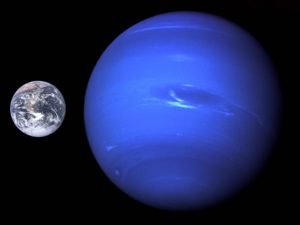Neptune in Darkness
Psalm 8:3-4
 “When I consider thy heavens, the work of thy fingers, the moon and the stars, which thou hast ordained; what is man, that thou art mindful of him? and the son of man, that thou visitest him?”
“When I consider thy heavens, the work of thy fingers, the moon and the stars, which thou hast ordained; what is man, that thou art mindful of him? and the son of man, that thou visitest him?”
Observations of the orbit of Uranus showed that it was somewhat irregular, so astronomers began to surmise that there must be another planet out there whose gravitational field was affecting it. Mathematical calculations – in a pre-computer age – led Urbain Le Verrier to calculate its position in 1845, and, in the following year, Johann Gottfried Galle found it where Le Verrier had said it should be. At 2.8 billion miles from the Sun, Le Verrier’s discovery had vastly increased the known size of the Solar System.
Once again, a new planet was to illustrate the great creativity of our Creator. The 1989 flyby of Voyager 2 – so far, the only spacecraft mission to Neptune – was able to discern storms, somewhat like Jupiter’s Great Red Spot. However, observations, using the Hubble Space Telescope, have shown that these storms come and go. In one storm spot, wind speeds of up to 1,300 miles per hour were recorded – the strongest known in the Solar System.
It is of interest that the surface temperature of Neptune is similar to that of Uranus, even though it receives only 40% the sunlight that Uranus gets. This is because Neptune generates some of its own heat internally. In fact, Neptune radiates about 2.6 times the heat received from the Sun. As yet, it is not known what causes this heat.
Creationist Dr. Russell Humphreys was able to predict the magnetic properties of both Uranus and Neptune before Voyager had measured them. This was by using biblical dates and conditions. Humphreys’ measurements were fully consistent with biblical research, as we would expect. Author: Paul F. Taylor
Thank You, Lord, for the intelligence of so many of Your servants, who have put their talents and expertise to good use. Amen.
Ref: Psarris, S. (2002), Neptune: Monument to Creation, < https://answersingenesis.org/astronomy/solar-system/neptune-monument-to-creation/ >, accessed 5/2/2018. Image: NASA, Public Domain.